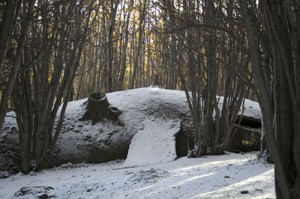« Reviews, Uncategorized
2nd Biennial of the End of the World

Adrián Villar Rojas. My Dead Family, 2009. Site specific sculpture. Wood, stones, cement and clay. In collaboration in Alan Legal, César Martins, Mariano Carsicano y Rubén Soto. 88’ x 9.85’ x 13’. Photo Kayné di Pilato
Ushuaia - Argentina
January 19 - May 31, 2009
By María Carolina Baulo
Artists from 16 countries participated of the Biennial of the End of the World in Ushuaia, Argentina from April 24th until May 4th; it was the second edition since it was created in March 2007 by the Patagonia Art & Challenge Foundation and sponsored by the Memorial of the Latin-American Parliament of Sao Paulo Foundation. The idea was to debate about contemporary issues, not only related with art, but life itself. An important announcement was made on opening night: the creation of a Polar Museum of Contemporary Art, Technology and Environment of the End of the World. The Biennial was also supported by the Brazilian Government, the National Antarctic Program of South Africa and by other initiatives such as a Pedagogic Project.
The well-known German curator, Alfons Hug, was in charge of the general organization; Alberto Saraiva represented Brazil, together with Fernando Farina from Argentina.
The theme was “the outdoors,” a term that refers to the large deserted spaces, the fragility of life compared to nature’s power and the uncertainty of living in an overwhelming twenty-first century. These are concepts that prevail in the social, cultural and historical situation of South America, not only because of its unprivileged location, but its political influence in the world.
The center of attention was the old hangar of 5,000 m2. At the entrance, a sculpture by the German Biörn Melhus, simulated a machine which destroyed clouds. Inside, four islands with screens reproducing videos simultaneously related to the four elements. Laura Glusman represented Argentina with a video of a woman swimming against the tide. Chris Larson, from the United States, pictured a machine which made ice cubes. Reynold Reynolds’ video represented a house setting on fire while a woman was sleeping inside, and Andrej Zdravic´s piece, from Slovenia, referred to the water-fire contrast`. The idea was to relate concepts like nature, progress and the usage of new technologies. A key situation was the fact that the spectator could never forget the leitmotif of the Biennial because of the cold atmosphere within the hangar.
The second attraction was the prison, closed in 1946, which showed the work of nine artists. Brazilian artist Katie van Scherpenberg presented an installation made of sand and lamps of kerosene inside the small, cold cells. The Argentine photographer, Guillermo Srodek-Hart, showed three videos, evidencing different ways in which animals and humans relate.
Finally, the old factory showed installations and videos and the Packewaia theater presented a short film by the German, Thomas Demand. An outstanding impression was caused by the Argentine artist Adrián Villar Rojas’ installation in the Yatana woods: My Dead Family, represented the shape of a whale of 28 meters long, an iconic figure lying as an archeological fossil in the middle of the forest.
The Biennial offered the possibility to gather the talent of different cultures incarnated in their artists, bound by the powerful ideal of creating conscious behaviors, an invitation to think about the reality we are building with our actions and the way we relate with the environment. Art allows, through different techniques and points of view, the manifestation of a common message; facing it, makes us all the same, at least as long as the experience lasts.
Maria Carolina Baulo: Art writer, Master’s Degree in History of Art, with studies in Cinematography, Photography and Theatre.


































